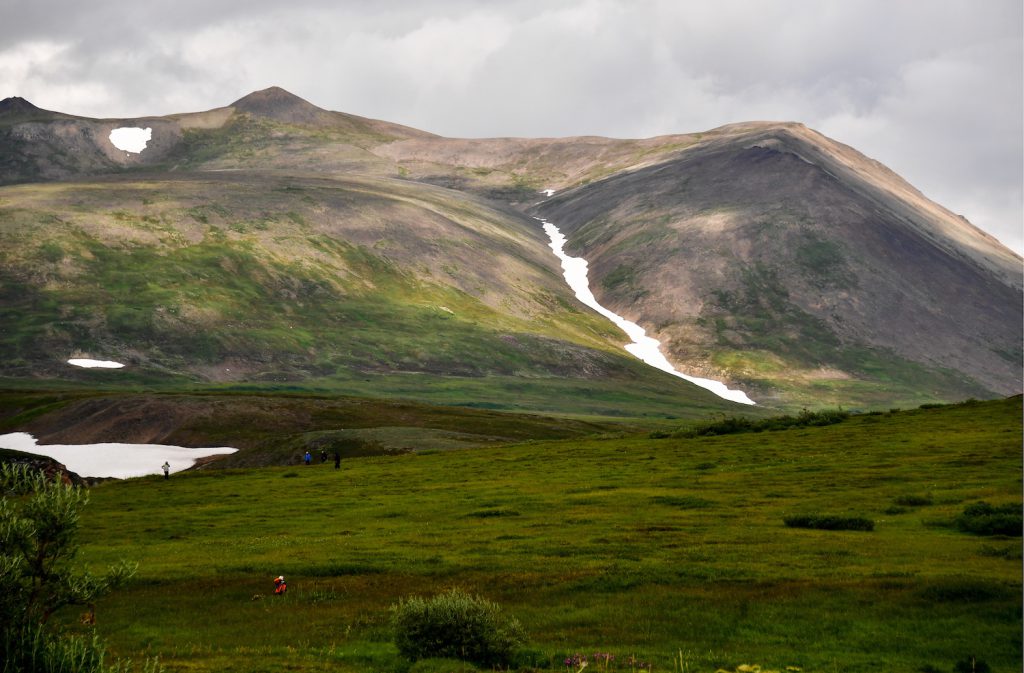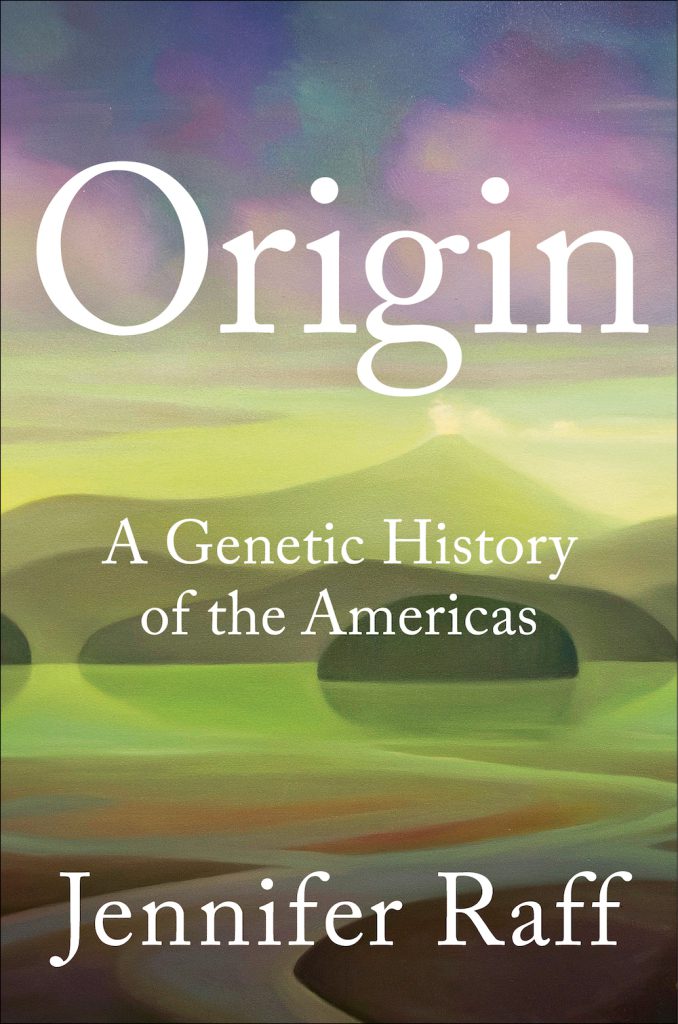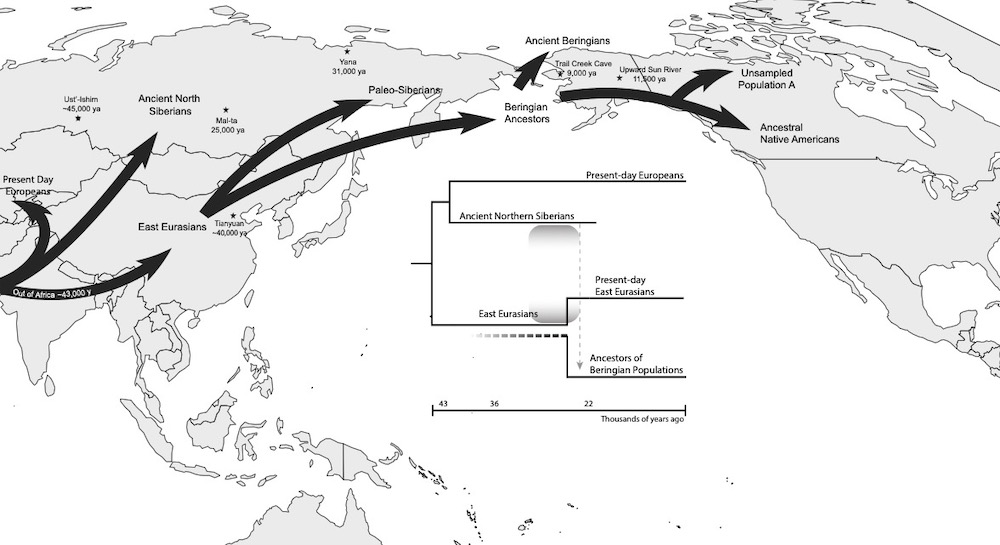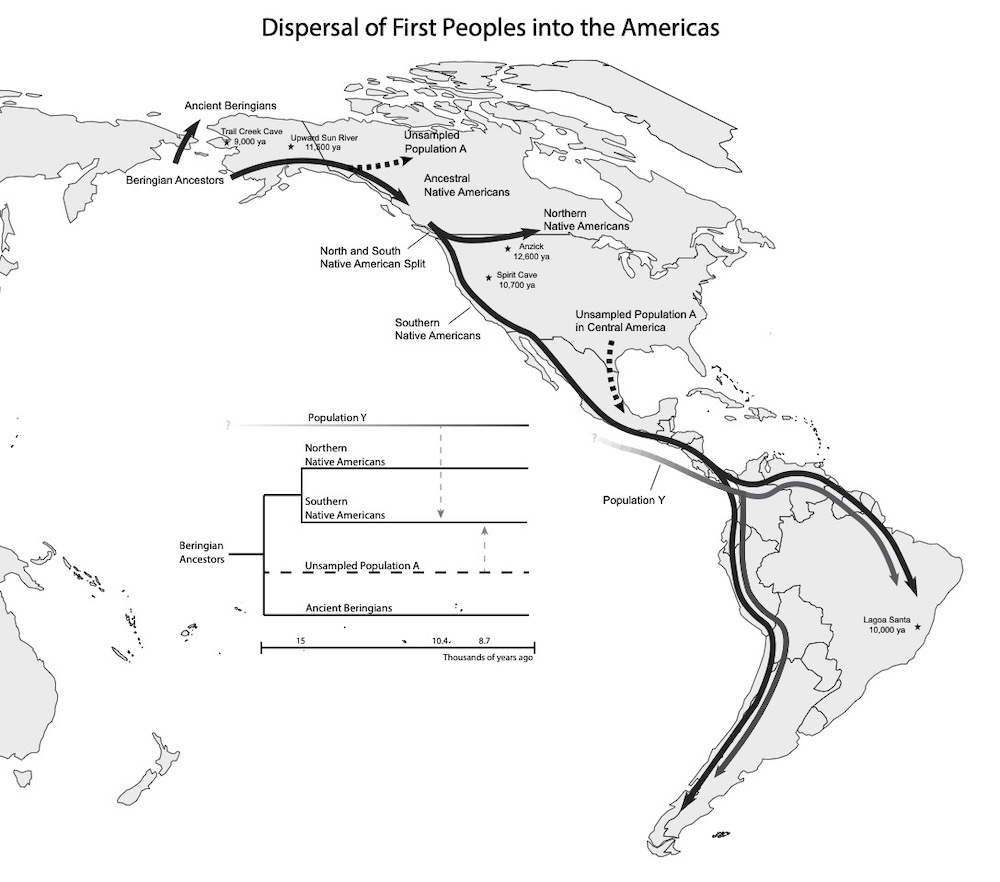A Genetic Chronicle of the First Peoples in the Americas

Excerpted from Origin: A Genetic History of the Americas. © 2022 by Jennifer Raff. Published by Twelve Books. All rights reserved.
We are living through a revolution in the scientific study of human history. Because of recent technical developments in approaches for recovering and analyzing DNA, plus sequencing whole genomes, geneticists’ and archaeologists’ ability to ask and answer questions about the past has improved dramatically.
Scientists once thought the peopling of the Americas occurred around 13,000 years ago, following the last ice age, when a small group of people crossed the Bering Land Bridge from Northeast Asia to Northwestern Alaska. In the last 10 to 20 years, however, a mountain of new evidence has emerged, showing us that people had been in the Americas for thousands of years before then.
This is not a surprise to Indigenous peoples, many of whom have Traditional Histories that situate their origins within what is today known as the Americas. Some Indigenous people view their origin stories as literal, while some see them as metaphorical and compatible with Western science. Indeed, some Native American archaeologists have demonstrated the importance of Oral Traditions in interpreting the archaeological record and call for careful and analytical study of these traditions and the integration of any clues they might give for understanding the past.
I present this history of the last 36,000 years of migration from the perspective of a Western scientist who places genetic evidence in the forefront of the investigation and then tests the models it produces with archaeological, linguistic, and environmental evidence. For many Indigenous peoples, this is not the whole story or the only story that should be told.
As you read this genetic chronicle, please do not lose sight of the dignity of the human beings who lived this history and the rich complexity of individual existences that are lost in the telling. The story I tell here is akin to reconstructing a person’s entire life by stitching together the photos they posted on Instagram. Not inaccurate, necessarily, just … incomplete.
Around 36,000 years ago, a small group of people living in East Asia began to break off from the larger ancestral populations in the region. By about 25,000 years ago, the smaller group in East Asia itself split into two. One gave rise to a group referred to by geneticists as the ancient Paleo-Siberians, who stayed in Northeast Asia. The other became ancestral to Indigenous peoples in the Americas.
Around 24,000 years ago, both groups independently began interacting with an entirely different group of people: the ancient Northern Siberians. Some archaeologists and geneticists argue that this meeting of the two grandparent populations of Native Americans—the group in East Asia and the ancient community in Northern Siberia—occurred because people moved north, not south, in response to the last glacial maximum (LGM), a period in which much of northern North America was covered by massive glaciers. Thus, many geneticists look north, to Beringia, for the location of the refugia that may have allowed the ancestors of Native Americans to survive the ice age.
Central Beringia is mainly underwater today, but it was a substantial land connection between 50,000 and 11,000 years ago. The term “Bering Land Bridge” gives the impression that people raced across a narrow isthmus to reach what is today Alaska. But the oceanographic data clearly show that during the LGM, the land bridge was twice the size of Texas.
If the “Out of Beringia” model is correct, Beringia wasn’t a crossing point but a homeland. It was a place where people lived for many generations, sheltering from an inhospitable climate and slowly evolving the genetic variation unique to their Native American descendants.
Either just before or shortly after the start of their period of isolation, the Beringians split into several groups: the Ancestral Native Americans, who would move south, below the ice sheets, and become ancestors of the First Peoples; the Ancient Beringians, who would stay behind in Beringia; and a mystery group (Unsampled Population A) known to us only indirectly from the traces of ancestry it contributed to some Mesoamerican populations.
About 17,000 years ago, on the western coast of present-day Alaska, the ice sheets began to melt, and the First Peoples expanded southward. This expansion left very clear imprints in the genomes of their descendants. Mitochondrial DNA lineages show us that after the LGM, people were suddenly and rapidly spreading out. Their populations were growing enormously—about 60-fold between about 16,000 and 13,000 years ago.
This population explosion is exactly what we expect to see in the genetic record when people move into new territories, where resources are far less limited, there is no competition from other people, and the game animals have no natural fear of humans, having never seen them before.
The story this rather dry genetic evidence reveals is breathtaking when you stop to think about it: A small group of people survived one of the deadliest climate episodes in all of human evolutionary history through a combination of luck and ingenuity. They established themselves in a homeland, from which their descendants—hoping to make a new and better life for themselves—ventured out to explore.
These descendants found new lands beyond their wildest expectations, entire continents (possibly) devoid of people, lands to which they quickly adapted and developed deep ties. These ties persisted through millennia into the present day and have not been severed despite climatic challenges and the brutality of colonialism, occupation, and genocide.
It was the nuclear genome from a small child—who himself did not have any descendants—that gave us the greatest insight into this process.
In what is today south-central Montana 12,600 years ago, a child died. Based on the archaeological evidence, I imagine what happened at the Anzick site like this:
Like all their children, the 2-year-old boy was treasured by his people. To honor him, they buried him underneath a rock shelter with great care and love, sprinkling his body with red ochre. Everyone in the community contributed to the toolkit that he would take with him into the afterlife: Some placed carefully flaked finished tools—projectile points, knives, and scrapers for hides—others left the cores that he would need to make new ones. His parents placed carved elk bone rods into the grave to mark his connection to their ancestors. This burial site was honored by their descendants for generations, who paid their respects to the boy every time they passed it. Two thousand years later, when another boy was suddenly taken from his family, they derived some comfort by burying him close to their ancient ancestor for protection.
The graves of these two children were found accidentally by construction workers in 1968. Because they were found on private land, their remains were not under the purview of the law that requires consultation and repatriation (if requested) with affiliated tribes.
Nevertheless, after the genome of the 2-year-old had been sequenced, researchers consulted with Indigenous peoples in Montana, including the Blackfeet, Confederated Salish, and Kootenai tribes; the Gros Ventre Tribe; the Sioux and Assiniboine tribes; the Crow Tribe; and the Northern Cheyenne Tribe. The tribes agreed that the children should be reburied in a safe place near their original graves, and their wishes were followed shortly after the publication of the study.
The children are referred to by archaeologists as Anzick-1 (the 2-year-old) and Anzick-2 (the 7- or 8-year-old who was buried there later). Anzick-1 was special not only to his parents and relatives (both in the past and across time), but also to the scientific community across the world. His remains were dated to between 12,707 and 12,556 years ago, making him the oldest-known person in the Americas—the only person who lived during the Clovis period whose remains are known to have survived to the present day. His genome was also the first ancient Native American genome to have been completely sequenced, and it has given us important insights into the First Peoples’ movements into the Americas.
The radiation of dog lineages that mirrors human lineages is extremely strong evidence for this model of migration.
Anzick-1’s complete nuclear genome—and those from additional ancient individuals that were sequenced in later years—show us that shortly after the LGM, the family tree of the First Peoples split into two major (and one minor) branches.
The minor branch, which diverged between 21,000 and 16,000 years ago, is currently represented by a single genome from a woman who lived on the Fraser Plateau in present-day British Columbia—known as the Big Bar Lake site to archaeologists—about 5,600 years ago. The fact that her lineage split before the two other major branches may reflect the divergence of her ancestors from other First Peoples as they were moving southward out of Alaska.
One major branch, which included Anzick-1 and his relatives, became the ancestors of many Native peoples of the present-day United States and everywhere south of that. This branch is referred to by geneticists as SNA (Southern Native Americans). The other branch, which is ancestral to populations of northern North America, including peoples who speak the Algonquian, Salishan, Tsimshian, and Na-Diné language groups, is referred to by geneticists as NNA (Northern Native Americans).
This split between the NNA and SNA branches tells us a lot about the initial peopling of the Americas. For one thing, most genetic evidence indicates that the split took place south of the ice sheets, because representatives of Ancient Beringians are equally related to members of the NNA and SNA groups. If those groups had split before they left Alaska, it’s likely that one or both groups would have intermarried with Ancient Beringians, resulting in Ancient Beringians being more closely related to one branch or the other.
We also see confirmation of this split and its timing from the mitochondrial genomes of dogs, who would have been closely associated with human populations. Dog mitochondrial genomes rapidly diversify into the four lineages found in ancient North American dogs at nearly the exact same time as the NNA/SNA split: about 15,000 years ago.
With the caveat that these mitochondrial data show us only a small fraction of dog population histories in the Americas—the edge pieces of the puzzle—the radiation of dog lineages that mirrors human lineages is nevertheless extremely strong evidence for this model.
Following the split between the NNA and SNA branches, people belonging to the SNA clade dispersed throughout North and South America very rapidly. We can see just how rapid this movement must have been when we compare the genomes of the most ancient peoples in the Americas. Despite being on different continents, 6,000 miles apart, the genomes of the Anzick-1 child, an ancient man from Spirit Cave in Nevada (10,700 years ago), and five people from the Lagoa Santa site in Brazil (~10,400 to 9,800 years ago) are very closely related to one another.
The story their DNA tells us is that between 15,000 and 13,000 years ago, the ancestors of people in Central and South America diverged from populations in North America. There are two pieces of evidence that strongly suggest that their movement southward was along the coast, rather than by inland routes.
First, the coast was open by 16,000 years ago, whereas the ice-free corridor between the two ice sheets probably wasn’t a viable route until about 12,500 years ago. Second, the pattern of population splits that the genomes reveal is so fast—nearly instantaneous—that the scientists who analyzed them likened the migration process as nearly jumping over large regions of the landscape. This fits more closely with southward migration by boat along the coast than with overland migration. By the time people got to South America, via the Isthmus of Panama, they may have expanded along both the east and west coasts.
This rapid first movement was followed by population growth, “settling in” to different environments, and gradual expansions. It was also followed by other significant migrations. After about 9,000 years ago, a group of people from Central America—ancestral to the present-day Mixe in the Mexican state of Oaxaca—spread throughout South America and mingled with all the populations there. They may also have migrated northward as well, as the genomes of people buried in the Lovelock Cave in Nevada (1,950 to 600 years ago) show us.
But as is typical in scientific research, this finding only raises more questions. What caused this movement? And how did traces of a new population in North America come to the Mixe genomes about 8,700 years ago? And finally, what is the explanation for very ancient traces of shared ancestry between people in South America and those in Australasia and Melanesia? (Genetics models suggest it was not the result of a trans-Pacific migration.) Finally, how does the new White Sands Locality II site in present-day New Mexico, which may date to the LGM, change our understanding of the genetic models?
We don’t have answers for these questions yet. We are only at the beginning of understanding the complexities of these histories using genetic and archaeological evidence.
Editors’ Note: This excerpt has been edited for style and length.




































